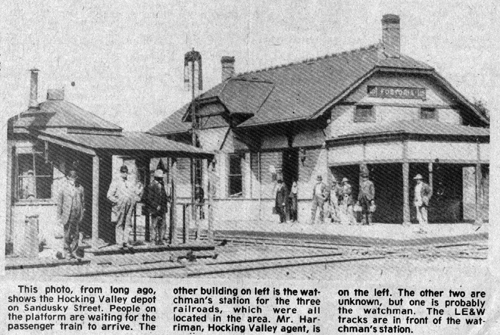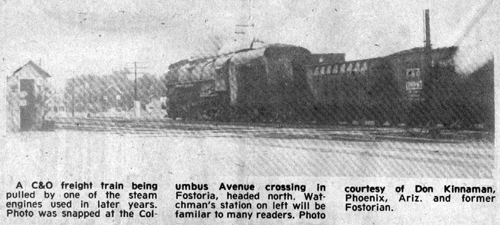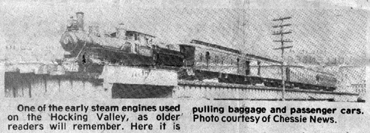July 28, 1983



Picture #1 – This photo, from long ago, shows the Hocking Valley depot on Sandusky Street. People on the platform are waiting for the passenger train to arrive. The other building on left is the watchman’s station for the three railroads, which were all located in the area. Mr. Harriman, Hocking Valley agent, is on the left. The other two are unknown, but one is probably the watchman. The LE&W tracks are in front of the watchman’s station.
Picture #2 – A C&O freight train being pulled by one of the steam engines used in later years. Photo was snapped at the Columbus Avenue crossing in Fostoria, headed north. Watchman’s station on left will be familiar to many readers. Photo courtesy of Don Kinnaman, Phoenix, Ariz. and former Fostorian.
Picture #3 – One of the early steam engines used on the Hocking Valley, as older readers will remember. Here it is pulling baggage and passenger cars. Photo courtesy of Chessie News.
(AUTHOR’S NOTE: The reason I have cautioned readers that the Sandusky Street series of articles might not appear in sequence is because I wasn’t sure if I could get the material collected and organized for each in time for each week’s publication. As it has turned out, there have been many photos discovered and loaned to me which have fit the text, in fact I have had to be careful not to have too many.)
Last week’s article brought us to the railroad tracks on Sandusky Street. The word “railroads” stirs a lot of memories for many area people and has contributed greatly to Fostoria’s history. Therefore, we cannot cross those tracks without devoting considerable space to them in this article.
Only the older resident readers will recall the first set of tracks east of the Superette used many years ago by The Toledo & Central (T&OC), running from Toledo to Columbus. Later, it became known as The New York Central and was taken over by Penn Central before its abandonment.
When it was the T&OC, it provided freight and passenger service. A great service was provided to dairy farmers and dairies since regular stop points along the line were established where milk cans were picked up and dropped off at the proper towns for processing milk and butter. Fostoria wa one of those towns.
Today, the depot and freight station used by the T&OC and its successors is a Gray Printing Co. warehouse.
A photo used with today’s article shows the passenger and freight station which was used by the Columbus, Hocking Valley & Toledo Railway (CHV&T) , but commonly termed “Hocking Valley,” later to become the Chesapeake & Ohio, now The Chessie System.
The building in the left of the photo is the crossing watchman’s station for all railroads at that intersection. There were no automatic gates then. It was the watchman’s duty to warn those on foot, in wagon, buggy or car of the approaching trains.
The CHV&T, already in operation in the early 1890s, was publishing “The Railway Reflector” in 1897, maybe even earlier. In January of that year, it devoted an entire issue to Fostoria.
In its 36 pages it illustrated and wrote all manufacturing plants, business places, schools, churches, important streets and people.
A few copies of the publication still are possessions of some Fostorians. I have referred to it on many occasions for photos and information, unavailable elsewhere.
I may never get another opportunity to write about the old Hocking Valley again, so I will take this opportunity to include some information about it, as included in “The Reflector.”
“The CHV&T Ry. is strictly an Ohio institution, its lines embracing 370 miles of main line, double track and branches, being confined to and traversing the Buckeye State from the Great Lakes at Toledo, south through the Capital City to the Ohio River at Pomeroy; the Hocking Division, Logan to Athens; more than 40 miles of branch lines penetrating the celebrated Hocking coal fields and operating the Wellston & Jackson Belt Railway, extending from McArthur Junction to Jackson, passing through the entire length of the Jack- son County coal fields. The Belt railway was completed during the past year (1986). That portion between Wellston and Jackson, 11 miles in length, bears the distinction of being the first railway in the U.S. upon which both steam and electric trains run under standard code rules and train orders. The CHV&T Ry. in connection with the Erie RR at Marion, Ohio, forms the short line between Columbus and Chicago.”
It was interesting to note from the discourse in “The Reflector” that back then their 80-ton locomotives pulled 50-coal cars loaded with 1,500 tons of coal.
After reading about the early history of “The Hocking Valley.” I talked with two former employees after it became the Chesapeake & Ohio, those being Roger Grashel, 131 Eagle St. and Willard Richardson, 932 Leonard St. Both worked in the mammoth maintenance shops at C&O at Logan, where hundreds of workers were employed. Later, both men were transferred to Fostoria, Grashel becoming yard master and Richardson, car foreman.
Both told me about the removal of many miles of track and other facilities of C&O property in the past few years. However, some years ago, two former C&O employees, after retirement, purchased a C&O locomotive and several passenger cars which are used for weekend excursion trips on some of the original C&O tracks.
Grashel told me that today the diesel engines used by C&O are capable of pulling much more than the old steam engines, however, the loads vary. One hundred sixty cars is an average. One diesel engine normally pulls 5,000 tons easily.
I lived within a stone’s throw of the railroads, heretofore discussed when I was a boy. Now, as I write this article and reflect, I would classify them as interesting, aggravating and invaluable.
It was always interesting to watch trains pass by, count the cars, note the variety of railroad companies represented and wave at the train crew.
It was aggravating to be held up by a train when in a hurry. The underpasses have eliminated much of that waiting, in fact all of it if they are used consistently.
About their value–the trains moved all of the freight in this country until the trucks got the upperhand. The trains were our greatest means for people transportation until they lost the freight business and could no longer stand any losses in passenger traffic. The airplanes also took a great toll on train passenger traffic.
What would this country have done during World War I and II if it had not been for trains to transport materials and troops?
With railroads modernizing their facilities and methods, today they are offering piggyback trains, namely flatcars on which loaded trailers are placed to be transported by rail instead of highway. Likewise, thousands of cars and trucks are now being shipped by rail instead of double deck trailers over the highways.
As for me, during boyhood, I combed the railroad yards in summer with my little red wagon picking up coal. By winter, I had accumulated quite a pile to help heat the house.
In later life, when I worked for The Fostoria Pressed Steel (Fostoria Indus- ties), I used the trains at every opportunity for travel instead of planes. There was excellent direct passenger service out of Fostoria to Detroit, Cincinnati, Cleveland, Chicago, New York, Columbus, Norfolk, with good connections to major cities. The ride to Norfolk on The Chessie was scenic with excellent pullmen and dining car service.
By getting up early in the morning, it was possible to get on a passenger train for Chicago and arrive there by mid morning, conduct business until about 3:30 p.m., then catch the 4:20 train back to Fostoria.
A 4:20 p.m. train on the Nickel Plate landed in Hoboken, N.J., at about 6 a.m. A ferry boat completed the trip to New York City in a short time.
Travel was more relaxing back then than it is today, in my opinion. I could write much more about the railroads in the Sandusky Street area, but already it has exceeded what I originally intended.
(To be continued).